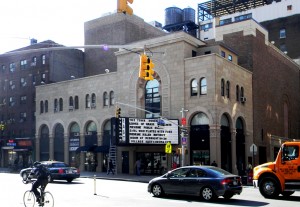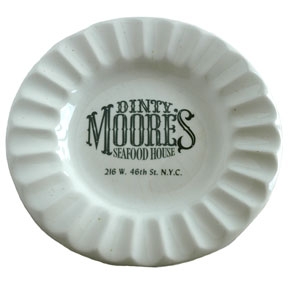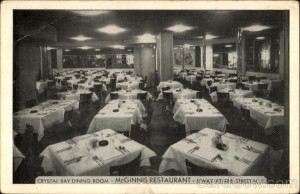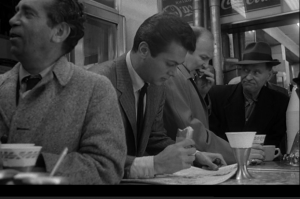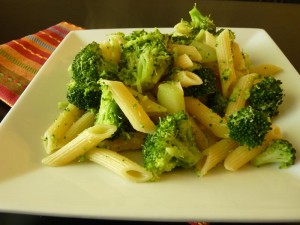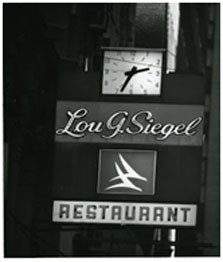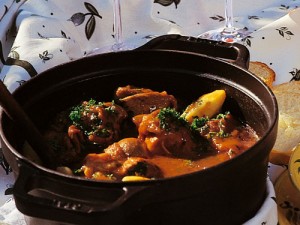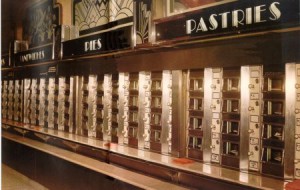The Cafe Royale, ah, the Cafe Royale!! Few people (and they are few, mainly men and women in their 90’s) who can say those words without a warm smile. The Cafe Royale had a long run: 1908-1952. It was located in New York on the corner of Second Avenue and E.12th (now a movie theater). For much of the cafe’s history, Second Avenue was the home of the Yiddish theater. There were numerous theaters and vaudeville venues. Stars galore: Jacob Ben Ami; Jacob and Celia Adler (their relations included Luther and Stella); Maurice Schwartz; Molly Picon; Menasha Skolnick. Aaron Lebedoff, Leo Fuchs and Moishe Oysher were vaudeville luminaries. Munii Weisenfreund (he changed his name to Paul Muni) and Walter Matthau were among the many actors who left the Yiddish theater to attain fame on Broadway and in Hollywood. HG only visited Cafe Royale in its final year — 1952. It was a sad place then, inhabited by old Yiddish actors bewailing (over numerous cups of tea) the death of a once vigorous theater. In its heyday, the Cafe Royale was the Yiddish Sardi’s—a schnapps and schmaltz fueled joint that teemed with Yiddish-speaking performers, composers, producers, set designers, musicians, press agents, dancers, playwrights—plus ardent fans and hangers on. It was one big Yiddish schmooze-fest and kibbitz. According to HG’s older friends, the Cafe Royale was the scene of theatrical feuds, naughty romance and artistic argument. The food and drink were savory. Voices were loud. Waiters were irascible. Hy Kraft, screenwriter and playwright, wrote a play about Cafe Royale, Cafe Crown. It opened on Broadway in 1942. Directed by Elia Kazan, it had a four month run. Kazan didn’t think much of Kraft as a playwright but said “He had a talent for the Jewish anecdote.” And, the play is as stuffed with Jewish jokes and anecdotes as an old Cafe Royale patron sitting back after a meal of chopped liver and Hungarian goulash. Joe Papp of New York’s Public Theater was fond of the Cafe Royale, the Yiddish theater and Cafe Crown. He revived the play in 1988 in a production starring Eli Wallach. Cafe Crown had another life in 1964. Kraft adapted it as a musical and HG/BSK went to the opening night. HG/BSK were pals with theater folks close to Kraft. The musical was not a success but it introduced a very engaging young actor, Alan Alda. HG/BSK joined Alda and his wife at Sardi’s for a post-theater dinner and found him to be a modest and amusing young man, surprising in someone whose star quality was so evident. Hy Kraft (he wrote it with Johnny Mercer) had a big hit in the Broadway musical (later a movie) Top Banana. It made Phil Silvers a star. Hy Kraft was an indomitable liberal. He defied the Red hunters and was blacklisted in Hollywood. Later, he battled against the American presence in Vietnam. The tragedy of his life was the early death of his daughter, Jill, a lovely and talented ingenue.
Cafe Royale
March 28th, 2014 § 0 comments § permalink
Stick-To-The-Ribs Eating
March 22nd, 2014 § 0 comments § permalink
Yes, that was the descriptive phrase for heavy, high-cal, stratospheric cholesterol, cheap food devoured by HG in New York during his college days. A real belly buster was mofongo, found in Puerto Rican restaurants in East Harlem, South Bronx and Broadway in the 140’s. Mofongo consisted of mashed, fried plantains (green bananas) formed into a big dumpling shape and served in a bowl of broth with garlic, olive oil and cuchifritos (pork cracklings). HG also ate big bowls of thick skinned potato pierogi with sour cream in Polish restaurants on lower First Avenue and giant plates of ground pork stuffed cabbage at Ukrainian restaurants in the same neighborhood. In African-American Harlem, HG feasted on fried catfish and ribs with mac-and-cheese, gravy doused rice and greens enriched by ham hocks. In the Mott Haven neighborhood of The Bronx, Mom-and-Pop Italian restaurants served bowls of spaghetti with oil and garlic of a size designed to appease the appetite of guys who worked all days with their hands and strong backs. Prices for these aforementioned treats ranged from 75 cents to $1.75.
Dinty Moore’s: Irish/Jewish and All Good
March 19th, 2014 § 4 comments § permalink
St, Patrick’s Day has come and gone and tons of nasty corned beef and cabbage have been consumed. Irish bacon and greens was the traditional holiday dish in Ireland. This got converted to corned beef and cabbage in the United States (HG doesn’t know when). Anyway, today’s inebriated Paddy’s Day revelers eat stringy corned beef (injected with lots of chemical tenderizer), limp cabbage and sadly overdone boiled potatoes. HG’s late Mom would comment: “Feh!!”. There was a time when corned beef and cabbage was a gourmand dish and it was served at Dinty Moore’s, an Irish restaurant on W. 46th Street in New York’s theater district. James “Dinty” Moore opened the restaurant in the 1920’s. Closed in the early 70’s. If Lindy’s and the Stork Club were identified with Walter Winchell, the powerful columnist and radio personality, Dinty Moore’s was identified with Louis Sobol of the Journal-American, the kindest and gentlest of the Broadway columnists. James Moore was the favorite restaurateur of the theatrical and sporting gentry because he defied Prohibition. He ignored it. It was always business as usual at Dinty Moore’s. Moore was often hauled into court but he paid his fines with a smile and kept serving good strong spirits. As the years rolled by, Moore recognized the fact that many of his customers were Jewish. He added gefilte fish (much better than HG’s Mom’s version) to the menu and the Irish lamb stew, beef stew and liver and onions were always made with kosher products. (The rasher of bacon that accompanied the liver and onions was decidedly non-kosher). Prices were high but were paid uncomplainingly because everything served was of the highest quality, plainly cooked and not disguised by intricate sauces. The signature dessert was rice pudding. It was sublime. It was a favorite of Jimmy Cannon, the eloquent sports columnist. A number of generations have grown up seeing Dinty Moore’s Beef Stew on supermarket shelves. No connection with the restaurant and HG doubts if it tastes anything like the wonderful New York food HG consumed at Dinty’s.
The Roast Beef Sandwiches Of Yesteryear
March 18th, 2014 § 1 comment § permalink
For many years the McGinnis Restaurant on New York’s Broadway (there was also a branch in the Sheepshead Bay neighborhood of Brooklyn) dispensed a lavish, rare roast beef sandwich. Its rival was The Brass Rail on nearby Seventh Avenue. The Brass Rail was adjacent to the Roxy movie palace (named after the showman “Roxy” Rothafel and demolished to make way for undistinguished office towers). The Brass Rail specialty was “The French Dip”. This was a roast beef sandwich on a mini-baguette dipped in a savory beef gravy. (Messy. But not as messy as the Chicago Beef Sandwich, a favorite in the Windy City). The best of all New York City roast beef sandwiches was served at Shine’s on 7th Avenue between 33rd and 34th Streets near Penn Station. There a stately African-American man in a chef’s hat carved slices behind a counter from a vast roast with surgical precision. On the more pedestrian side, HG liked the roast beef sandwiches served at many of New York’s old fashioned Jewish delicatessens in Brooklyn and the Lower East Side. A nice smear of chicken fat on seeded rye. Roast beef. Coarse salt. Black pepper. Sliced sweet onion. In the days when Harlem was a Jewish neighborhood, there was a Harlem delicatessen (name, alas, forgotten) that served the sandwich and attracted customers who had to patiently wait in a long line in order to enjoy the treat. The Chicago Beef and the Philadelphia Cheese Steak never caught on in New York. The New York attitude: “Why hide the flavors of delicious rare roast beef carved from a prime rib, corned beef, pastrami and brisket?” Why, indeed? HG/BSK had a delightful Saturday tradition after shopping at Bloomingdale’s.. HG/BSK would visit nearby Dover Delicatessen and pick up roast beef, ripe Liederkranz cheese, a sliced rye bread, potato salad, cole slaw. HG/BSK liked their roast beef sandwiches with Russian dressing. The cheese was showered with chopped onions and paprika. Much fun.
When The Great White Way Was Appetizing
March 17th, 2014 § 0 comments § permalink
There is a glittery expanse of Montparnasse in Paris that is filled with movie houses, creperies and four landmark restaurants. The super-pricey (and worth it) Le Dome which serves the best grilled sole in Paris (the fish swims in sublime lemony melted butter). La Rotonde which has fine oysters and steak tartare. Select (nice for a pre-dinner drink). La Coupole (beautiful art deco decor and fine oysters but everything else is miserable in this chain-operated trap for tourists). Montparnasse reminds HG of New York’s Broadway in its glory days (which ended in the 60’s). There were the big time movie houses: Paramount (where Frank Sinatra thrilled the bobby soxers); Capitol, Strand (all with stage shows in addition to first run movies)). Also Criterion, Trans-Lux, Palace, etc. Loads of good restaurants (mass and class) starting at 42nd Street and moving north into the 50’s where they gave way to auto showrooms. Here were some of them: Hector’s Cafeteria (good, cheap food); Rosoff’s (excellent roast duck); Turf (fine cheesecake); McGinnis’ (lavish roast beef sandwiches plus sea food specialties); Jack Dempsey’s (The champ served fine steaks). Just a few steps oiff Broadway was Gluckstern’s, a top flight Jewish kosher restaurant (not to be confused with the OTHER Gluckstern’s that was on Delancey St.). Also just off Broadway was Dinty Moore’s (best corned beef and cabbage plus liver with onions and bacon). The unquestioned essential Broadway restaurant was Lindy’s. Immortalized in Damon Runyon’s fiction. Comedians like Milton Berle, Jack E.Leonard, Jack Carter and Henny Youngman topped each other with one liners in its environs. It was where the powerful columnist Walter Winchell lunched. Song writers, bookmakers, gamblers, press agents, actors, producers, musicians and other colorful folk filled the tables. The food, which ranged from Jewish-American specialties to superb pork sausages with eggs, was splendid. And, the cheesecake was legendary (even better than Junior’s or Turf). What happened to the wonderful New York cuisine that Lindy’s exemplified? Gone. The world changes and not always for the better.
Eating Cheap on the Path to Stardom
March 11th, 2014 § Comments Off on Eating Cheap on the Path to Stardom § permalink
More than 50 years ago, young actress BSK arrived in New York after a year at Milwaukee’s Fred Miller Repertory Theater. BSK had 75 dollars in her purse. Fortunately, she also had some good culinary advice from experienced actors who had been living in New York for some time: If hungry while making the rounds of casting offices go to Grant’s on W. 42nd Street (two hot dogs for a quarter and french fries for 12 cents) and the Horn & Hardart Automat at 1557 Broadway (opened in 1912, the first Automat in New York). Yes, the theater district had many cheap food options for the famished, talented and impecunious. One of HG’s favorites (might have disappeared before BSK arrived) was Romeo’s. In its 42nd St. window a big guy in a tall chef’s hat plucked spaghetti from a cauldron of boiling water, plated it and added a dollop of very red meat sauce. The spaghetti (and garlic bread) cost 25 cents. There were also a few Elpine locations on Broadway. They dispensed hot dogs and papaya drinks. You can view an Elpine in the movie Sweet Smell of Success.” Tony Curtis (as press agent Sidney Falco) grabs an economical meal there. BSK received another piece of New York advice. Register with Brown’s Temporary Personnel. You’ll be able to work part time and still have an acting career. BSK followed the advice. Brown’s sent her to HG’s public relations office. The rest, as the cliche would have it, is history.
Pasta Joys
February 26th, 2014 § 0 comments § permalink
It may seem like HG is referencing the Middle Ages, but back in the 1970s pasta was still a fairly exotic term while spaghetti ruled the roost when it came to Italian noodles dishes. The great wave of wonderful pasta dishes and their sauces had yet to arrive in the typical american pantry. In fact, HG first tasted penne with broccoli at Delsomma, a wonderful (alas, long closed) Italian restaurant on W. 47th Street in New York. (HG wrote about the restaurant: Gone But Not Forgotten Restaurants: Delsomma…Sept. 2011). Loved the dish and it became a mainstay in the HG/BSK home. BSK makes the broccoli sauce this way: Blanches florets and stems in the boiling pasta water. Purees some of the broccoli in the blender with chicken stock. Sautes the rest of the broccoli in olive oil with anchovies and minced garlic. It’s all blended with parmesan and poured over the pasta with a dusting of red pepper flakes and chopped parsley. Mighty good. Giuliano Bugialli, the esteemed Italian pasta authority, suggests another way to make penne with broccoli, a method popular in southern Italy. The broccoli is cooked with the pasta. First, the stems are added to the boiling pasta. After two minutes, the florets go into the pot. in 12 to 15 minutes the pasta is al dente and the broccoli is cooked. Minced garlic, red pepper flakes and capers are heated in olive oil and poured over the broccoli and pasta. Showered with chopped parsley. HG will try this method but will add anchovies, an ingredient that complements the sponge-like nature of a broccoli floret.
While it may seem difficult to find a new method to making pasta, BSK did just that a few days ago: Cauliflower-bacon-penne risotto. That’s right. Risotto made with penne pasta instead of rice. BSK roasted cauliflower florets with a dusting of cumin. Fried thick cut bacon to crispness. Deglazed the bacon pan, sauteed some garlic and added the bacon and roasted cauliflower. Cooked the penne like Arborio rice. In a heavy saucepan, cooked sliced onion in olive oil until transparent. Mixed the softened onions with penne. Added chicken stock. Tossed in a tablespoon of dry white wine. Brought liquid to a boil. Reduced to medium high and then simmered. HG stirred the mixture until the penne had absorbed the flavorful broth and was al dente. HG made sure some starchy broth remained to make a sauce. In went the cauliflower-bacon with Romano cheese, Maldon Smoked Sea Salt Flakes and ground pepper. A perfect dish wish a green salad and red wine. Pasta still has many joys.
New York Nostalgia Part 3 (The Jews)
January 24th, 2014 § 0 comments § permalink
Two events, one tragic and one sad, took place in New York City some 18 years ago. For HG, these events marked the end of New York’s Jewish ambience. Sure, the New York of that time, like today, had multitudes of Italians, Irish, African-Americans, Asians, and Hispanics. But, it was the Jews who set the overall tone of the city. The tragic event took place on March 5, 1996. On that day, Abe Lebewohl, the proprietor of the original Second Avenue Delicatessen (2nd Avenue and 10th Street), was shot and killed as he delivered cash receipts to a nearby bank. Lebewohl not only ran a great Jewish delicatessen, he was also a direct link to Second Avenue’s colorful past as the home of Yiddish theater. And, he honored that past by naming one of the delicatessen’s dining rooms after Molly Picon, a Yiddish musical star (and a favorite of HG’s Mom). Wonderful Jewish delicatessens like Gitlitz (79th and Broadway) are gone. Katz’s remains on the Lower East Side — a stalwart in these lean deli times where the venerable Carnegie Deli has devolved into a grotesque tourist trap known only for the over-stuffed size of their sandwiches.
The sad event was the closing of Lou G. Siegel’s on June 29, 1996. It had been in business for 79 years. Lou G. Siegel was a distinguished and dignified restaurant in the heart of New York’s Garment Center (38th Street just west of Seventh Avenue). It was strictly kosher (there were two Rabbis on the payroll) and the food was delicious, hearty and caloric. It was where observant Jewish (were there any other?) clothing executives dined. The non-observant big shot Jews ate at Al Cooper’s, further east on 38th. The garment workers frequented Dubrow’s and the other very good cafeterias in the vicinity. They are all gone. Seventh Avenue has been named “Fashion Avenue”. The Garment Center with its rabid union members, gangsters and famed lunchtime schmooze is now the Fashion District. The habitues of Siegel’s kingdom of chicken fat and rugelach would have a sardonic laugh. Siegel’s was the best of a host of traditional kosher restaurants that served meat ( Kosher law, “kashriuth”, forbids the mingling of meat and dairy products). Some of the other restaurants of that type were Moskowitz & Lupowitz and Gluckstern’s. Sammy’s Romanian (Allen and Delancey) is a survivor. The food (non-kosher) is tasty. The prices are steep. The atmosphere is a Jewish parody, a broad dialect joke. The great, strictly dairy (and fish) Jewish restaurants (Ratner’s, Rappaport’s, Steinberg’s, Paradise) are gone although some smaller operations still exist. This is not to say that there aren’t kosher restaurants left in New York — There are plenty of them spread throughout the five boroughs, catering to a new generation of the observant and a new group of Israeli and Russian Jewish immigrants. The menus would be un-recognizable to the observant Jews of fifty years ago as they feature kosher sushi, kosher Italian and kosher Indian food (amongst others). The restaurants HG misses most are those that were not kosher and had wide ranging menus that included, but were not confined to, Eastern European Jewish food. The three greatest, of course, were Lindy’s, Reuben’s and Tip Toe Inn. Gone. New York has, for better or worse, lost much of its Jewish flavor. It is now a truly international city with a cuisine to match. No, New York is no longer Jewish but it if you are hungry it’s a great town.
New York Nostalgia (The French)
January 21st, 2014 § 2 comments § permalink
HG learned to love French food more than six decades ago. At that time, New York had many modest French bistros in the theater district; but, the really rough-and-ready, down-home French cuisine was found in the bistros west of Ninth Avenue. These were the joints that catered to French sailors from the Ile de France and other cruise ships that docked on the Hudson River. A meal cost about $1.50 (with wine). Lots of offal. It was in these bistros that HG learned to love tete de veau, kidneys, liver, gizzards, brains, etc. There were also some delicious, long simmered winy stews. Beef cheeks (never on an American menu) were a fave of HG’s female companions — fastidious damsels who didn’t fancy the organs ordered by HG. The French dining was often preceded by a good foreign film at The Stanley on gritty W. 42nd Street. A ticket was 35 cents. Apres dinner was garlic scented lovemaking in the best case scenario (or chaste companionship in the worst) in a $30 a month one room apartment on the West Side or Greenwich Village. Ah, ardent youth in a long ago, long gone, cheap New York.
Christmas Restaurant Nostalgia The Finale: Bickford’s & The Automat
December 22nd, 2013 § 0 comments § permalink
Some 60 years ago, HG was a New York journalist. There was a pleasant custom at International News Service/International News Photos (where HG was employed). Jewish journalists would volunteer to replace their non-Jewish colleagues on Christmas Eve and Christmas Day so the non-Jews could enjoy these holidays with their family. And, that’s why HG worked at the news desk on Christmas Eve and Christmas Day. Where to have dinner? HG’s favorite dining places were closed. The shot-and-beer-chaser bars were open but populated by maudlin or surly drunks. HG’s workplace was on E. 45th, just east of Third Avenue ( at the time, the El was still rumbling overhead). Nearby Lexington Avenue had a Bickford’s Restaurant on the northeast corner of 45th and a Horn and Hardart Automat on the southeast. So, Christmas Eve HG dined (with good appetite) at Bickford’s. The special of turkey with all the fixings (and extra gravy upon HG’s request) was tasty. Dessert was pumpkin pie a la mode and HG “corrected” his coffee with cognac from HG’s concealed flask. Christmas Day found HG at the Automat. Three hot casseroles were lined up before HG (plucked from the Automat’s windowed wall of savories): Beef Pie, Macaroni and Cheese, Baked Beans (topped with a strip of bacon). Coconut custard pie for dessert. “Corrected” coffee. Well meaning friends expressed concern that these meals might prove depressing. They were not. Yes, HG’s fellow diners were not a jolly group. But, the lonely folk were quiet and unobtrusive, allowing HG the peace in which to read a bundle of newspapers while sipping brandy-laced coffee.
